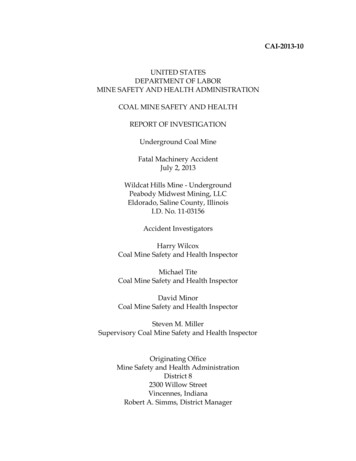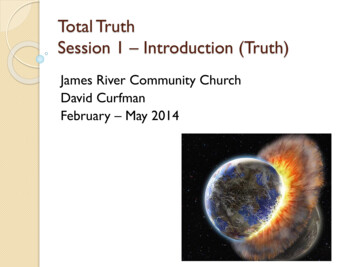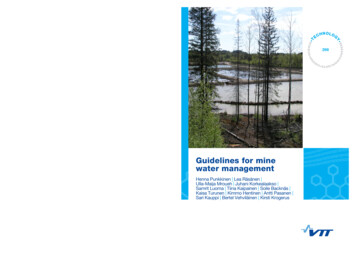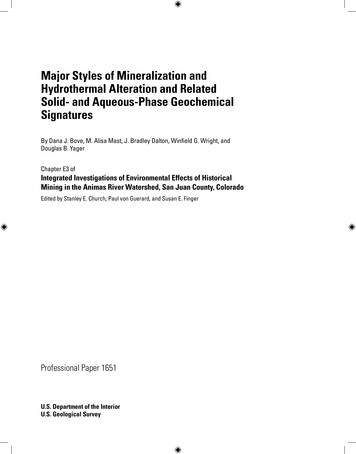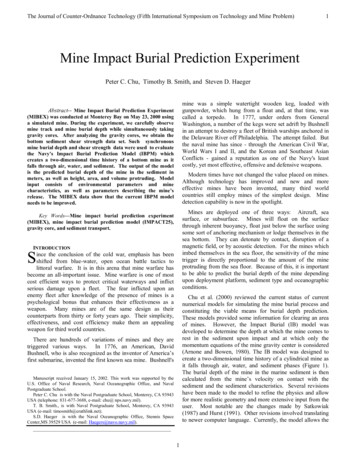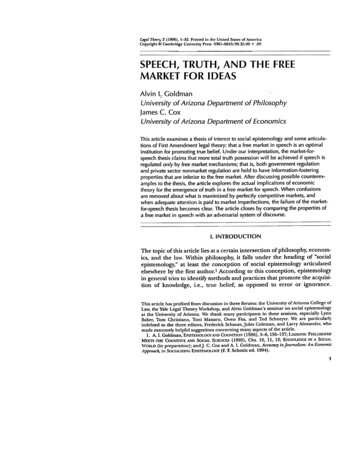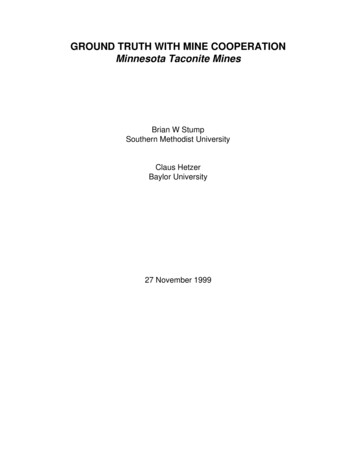
Transcription
GROUND TRUTH WITH MINE COOPERATIONMinnesota Taconite MinesBrian W StumpSouthern Methodist UniversityClaus HetzerBaylor University27 November 1999
INTRODUCTION AND GOALSDetection, location and identification of mining explosions using regional seismic andacoustic observations can minimize the number of false alarms that might arise as aresult of monitoring of the Comprehensive Nuclear Test Ban Treaty. The preliminarywork described in this document is intended to illustrate one way in which informationabout blasting provided by a mine operator may be useful in improving monitoringfunctions.A cooperative arrangement has been developed with a large taconite mine in theMesabi Iron Range of Minnesota. Explosives are used to fracture relatively hard rockformations in order to facilitate the recovery of iron. The mine is known as Minntac andis operated by the U. S. Steel Group.Since June of 1999, the mine has been supplying Southern Methodist University withground truth information that includes shot time, total amount of explosives and amountof explosives per delay period. The information is typically provided within 24 hours ofthe blasts and provides an opportunity to investigate the usefulness of such timely datain a monitoring scenario. Additionally, the information can be used to assess therelationships between regional seismic and infrasound observations and the blastparameters.The primary regional data set used in this study has been obtained through theAUTODRM process. Taking advantage of the large number of stations in the US andCanada that can be accessed in this manner we are building a regional data set tocompliment the ground truth information.This document is intended as a progress report of an ongoing research effort focusedon understanding regional signals from hard rock mining practices. Mining operations inthe Mesabi Iron Range and at Minntac in particular will be summarized in the firstsection. This will be followed with examples of the regional data set that isaccumulating. Finally some simple interpretations of the data and possible conclusionswill be discussed in the final section of the report.
MINNESOTA TACONITE MINESThe Mesabi Iron Range is located in Northern Minnesota. It has been actively minedsince ore was first discovered in 1890. The iron ores are composed of high-grade, softmaterials which early on were relatively easy to extract even with steam shovels. Asthese ores have become depleted, mining has turned to the surrounding hard rockmaterials with magnetic iron particles distributed throughout. These taconite depositscontinue to be mined today requiring extensive blasting in the very hard rock. Typicalcompressive strengths for these rocks are found to be between 30,000 psi to 90,000psi.The Minntac Mine is one of the large taconite mining operations in this region. Figure1a is an overview of the facility at the mine which takes the raw ore and processes it toform small iron balls that are then shipped to steel manufacturing plants. The mine isoperated by U. S. Steel. Donald H. Thompson the senior engineer for drill and blast hasbeen our point of contact in this cooperative study.Figure 1a: Aerial view of the processing facility at the Minntac Mine(www.usx.aa.psiweb.com)Figure 1b: Minntac is operated by U. S. Steel. The point of contact for this study is DonThompson, Senior Engineer for Drill and Blast.
Minntac drills over one million feet of 16 inch diameter boreholes each year to produce75 million long tons of taconite. An example 16" borehole is loaded with 36' of ANFOfor a total explosive weight of 4236 lbs with an explosive factor of 0.82 lbs/ton.Individual shots will consist of up to several hundred boreholes delay-fired. Since June,the ground truth data base has grown to fourty-three events. As Figure 2 illustrates,these mining blasts are typically detonated around the noon hour.MINNTAC SHOT TIMES14:2412:009:367:12Series14:482:240:00Calendar DateFigure 2: Shot times for the Minntac blasts from June-November 1999.The amount of explosives in individual boreholes in the shots can vary from near 1000lbs to over 4000 lbs. These individual charge sizes result in maximum lbs of explosivedetonated in any delay period from 1000 to 15000 lbs. Total charge sizes have rangedfrom 63000 lbs to 790000 lbs during the study. The total number of boreholes in eachshot have ranged from 75 to 287. Figure 3 plots the total explosive weight in anindividual shot versus the total number of boreholes. The increase in total explosiveswith the number of boreholes is a result of the delay-firing process. In this figure thediameter of each symbol is proportional to the maximum amount of explosivesdetonated in any one delay period. There are shots at all sizes with near the maximumamount of explosives per delay period. There are also shots with smaller amounts ofexplosive per delay period that fall to the bottom of the distribution of total shot size for afixed number of boreholes.It has been well documented that there is little relation between total explosive weightand regional seismic amplitudes. We intend to investigate these relations for this data
set with additional comparison to amount of explosives per delay period. The limit onthe total amount of explosives per delay period is intended to limit close-in groundmotions from blasting and might affect regional amplitudes. As Figure 3 illustrates,there are shots with the maximum amount of explosives per delay period at all values oftotal amount of explosives. One might expect then that regional signals from this minemight not show a positive correlation of total explosive weight with regional amplitudesbut would show a positive correlation with maximum amount of explosives detonated inany delay period. The effect of delay on local and regional amplitudes will naturally befrequency dependent.SIZE OF MINNTAC 00250300350-100,000Number of Blast HolesFigure 3: The total amount of explosives detonated in a blast is plotted against thenumber of boreholes in the blast pattern. The diameter of the symbol is proportional tothe maximum amount of explosives detonated in any delay period.One way of characterizing the blasts and their efficiencies is to compare the total lbs ofexplosives to the tons of material blasted. Typical this ratio is called the powder factorand can vary from small values (0.1 to 0.3) for weak materials that are easily broken tolarge values (0.7 to above 1) for hard materials or where cast blasting is employed. Asnoted earlier, the relatively large blasting factors reflect the large compressive strengthsof the rocks in this region.The total amount of explosives in lbs is plotted against the total amount of fractured rockin tons in Figure 4. An apparent linear relation is found for the blasts studied at Minntac.This relation illustrates that as the total amount of explosives is increased at the minethe amount of rock affected by the explosives increases linearly.
MINNTAC TOTAL EXPLOSIVES VS ROCK MASS900,000800,000y 0.6985x 412482R 0.7509700,000600,000500,000Series1Linear (Series1)Linear 060000080000010000001200000Rock Mass (tons)Figure 4: The total amount of explosives in lbs is plotted against the total amount ofrack fractured by the explosion in tons.REGIONAL OBSERVATIONSThe key to this the study is the determination to what extent simple blasting records canbe utilized in regional studies of mining explosions. The blast records that have beensummarized in the previous section provide the trigger to request seismic data inspecified time windows. The seismic stations surrounding the mine are listed in thetable below. The closest station is EYMN at 112 km and the farthest listed in the AAMBLOCCMCBKSFCCMIARType 3C34.5457Longitude Elev-92.52767-91.495 0.475-89.4083 0.468-92.0812 0.373-95.875 0.281-96.018 0.281-96.027 0.281-96.013 0.281-96.039 0.281-90.2488 0.318-82.50790.21-83.65611 0.249-86.52222 0.246-91.24458 0.223-99.73739 0.677-94.0866 0.039-93.573 4355291753
is MIAR at 1435 km. Many of these stations operate an AUTODRM so that automatedrequests for data can be sent.Broadband vertical records at EYMN for 10 of the Minntac blasts are plotted in Figure 5.This simple display of the data illustrates three important characteristics of the data.First, the waveforms from one shot to another are very similar. This might be furtherinvestigated through a correlation analysis. Second, at this close range (112 km), thefundamental Rayleigh wave known as Rg has large amplitude. This secondary phasedominates the longer periods. Third, the P wave coda is very well excited.Figure 5: Ten, vertical broadband seismic records of Minntac blasts recorded at EYMN(112 km).Data from a second station, ULM, is reproduced in Figure 6. This station at 398 kmillustrates the effect of increasing propagation path distance on both the character andthe signal to noise ratio on the signal. At this greater range the Rg phase is no longer
observable. The waveform consists of a P package and a Lg package. Some of thesmaller events such as the 14 July are just barely observable above the backgroundnoise. This result suggests that the mining shots from Minntac despite ranging in totalexplosive weight to nearly 800,000 lbs may only be observed at near-regionaldistances.Figure 6: Eight, vertical broadband seismic records of Minntac blasts recorded at ULM(398 km).PRELIMINARY ANALYSIS AND CONCLUSIONSTimely cooperation with an active mine has proven that shot records can be used todevelop a data base of regional seismic signals from blasting. The key to this study hasbeen the availability of blast records within 24 hours of the explosions. This informationhas then been used to assemble a the set of all available seismic records usingautodrm. The procedure avoids the need to wait for data archives to be made availableand provides quick study of events of interest.
A number of simple measurements on the waveforms developed during this study arepresented to further illustrate the importance of the explosive source on the waveforms.Figure 7 contains bandpass filtered time series from one of the blasts observed atEYMN. This representation illustrates further the importance of Rayleigh waves at thelonger periods. Even though the observations are only at 112 km one can also see thedevelopment of Lg in the 1-2 and 2-4 Hz band. Finally the relative importance of the Pwaves increases at the highest frequency band.Figure 7: Bandpass filtered time series of one Minntac blast observed at EYMN.A similar filtered representation is made for station ULM in Figure 8. There is little or nolong period signal (0.1 to 1 Hz) at this more distant range. The Rg phase has probablybeen destroyed by heterogeneity in the shallow crustal wave guide. The Lg phase isnow well developed at intermediate frequencies. P energy has its largest relativecontribution at the highest frequencies.
Figure 7: Bandpass filtered time series of one Minntac blast observed at ULM.Peak amplitude of P and Lg waves were measured in different frequency bands in orderto determine the effect of charge weight an regional seismic amplitudes. Figure 8 plotspeak P wave amplitude in three frequency bands (2-4, 4-8, 8-16 Hz) against themaximum pounds of explosive per delay period. Typically the delay period over whichthe charge size is determined is 8 ms. All frequency pass bands show increase in peakamplitude with increasing pounds per delay. The signal strength of the P wave isgreatest at the higher frequencies. The 8-16 Hz pass band shows the strongestincrease in peak amplitude, consistent with the delay period being very short.Similar comparisons are made for the Lg waves in Figure 9. The pattern is much morecomplex in this case with the largest amplitudes at the lower frequencies.Measurements were made out to the 8-16 Hz band although the phase measured maynot be strictly Lg. The fact that Lg is dominated by lower frequencies may mean thatpeak amplitudes of this phase may not directly reflect the lbs per delay period but mayreflect the amount of explosives detonated over a time period more comparable to theinverse of the frequency dominating the phase. We intend to investigate this possibilitythrough additional data analysis and modeling.
Average P Peak Amplitudes140120100R2 0.6584Avg. Peak P Amplitudes (2-4 Hz)Avg. Peak P Amplitudes (4-8 Hz)Avg. Peak P Amplitudes (8-16 Hz)Linear (Avg. Peak P Amplitudes (8-16 Hz))Linear (Avg. Peak P Amplitudes (4-8 Hz))Linear (Avg. Peak P Amplitudes (2-4 Hz))806040R2 0.154920R2 0.226900500010000150002000025000Pounds per DelayFigure 8: Peak P wave amplitude for three frequency bands (2-4, 4-8, 8-16 Hz) plottedagainst the maximum charge weight per delay period.Average Peak Lg gPeakPeakPeakPeakPeakAmplitude (0.1-1 Hz)Amplitude (1-2 Hz)Amplitude (2-4 Hz)Amplitude (4-8 Hz)Amplitude (8-16 Hz)1501005000500010000150002000025000Pounds per delayFigure 9: Peak Lg wave amplitude for three frequency bands (2-4, 4-8, 8-16 Hz) plottedagainst the maximum charge weight per delay period.
FUTURE WORKThrough cooperation with personnel at Minntac, we have begun a study of regionalseismograms from a hard rock mine in Minnesota. Data provided by the mine andregional broadband seismograms provide the basis for beginning the assessment ofissues related to explosive coupling and event characterization.It appears that this study can be extended to infrasound recordings as well.Discussions with David McCormack at the Canadian Geological Survey have indicatedthat mining blasts in the Mesabi Iron Range are generating infrasound signals at IS10 inCanada, near ULM. Signals from three blasts at one element of the infrasound arrayare reproduced in Figure 10. These data in conjunction with the ground truth from themine will allow this study to be extended to include both seismic and infrasound signals.Figure 10: Infrasound signals on one element of IS10 near ULM. They represent threemining explosions in the Mesabi Iron Range.
Much work remains in this initial empirical study. We continue to expand the data basewith input from Minntac. Additional sources of seismic data are being investigated.Cooperation with the Canadian Geological Survey is anticipated in order to extend thestudy to infrasound signals.After completion of the data gathering and interpretation phase, we intend to begin amodeling exercise of the seismic data. Our intention is to first investigate couplingissues associated with these delay-fired explosions. Particular emphasis will be placedupon replicating the relative characteristics of the peak amplitude data in the differentfrequency bands. The data set also offers the opportunity to investigate possible miningexplosion discriminants for stable continental propagation paths.ACKNOWLEDGEMENTSWe would like to thank Donald H. Thompson and his staff at U.S. Steel Group,Minnesota Ore Operation for their cooperation in developing the ground truth data base.David McCormack at the Canadian Geological Survey has provided the opportunity tocompare the seismic signals to infrasound recordings. The initial work with autodrmwas made possible with help from Jessie Bonner and Chris Hayward. Tom Goforth isacknowledged for his support and guidance in this research.
ground truth information that includes shot time, total amount of explosives and amount of explosives per delay period. The information is typically provided within 24 hours of the blasts and provides an opportunity to investigate the usefulness of such timely data in a monitoring scenario
